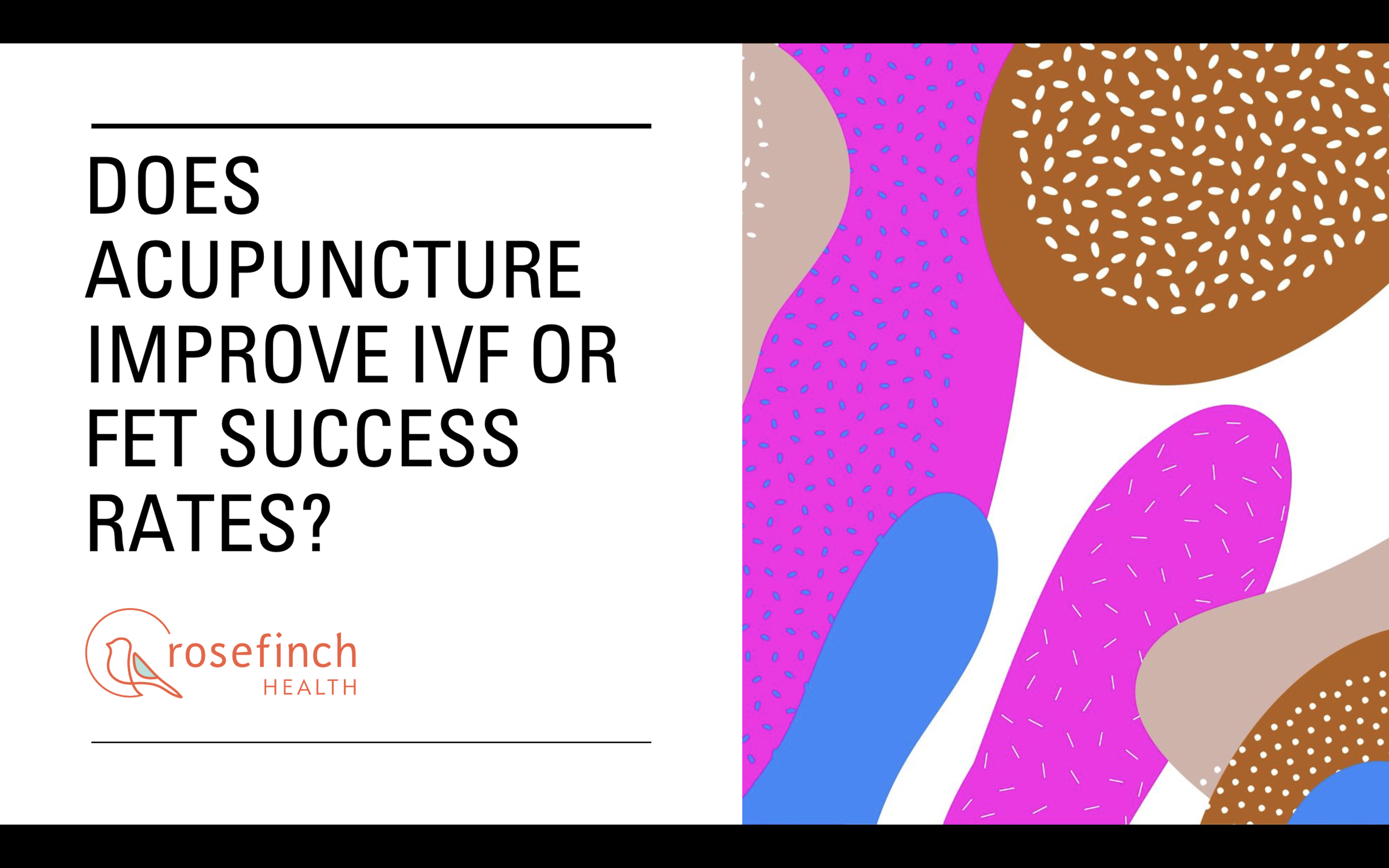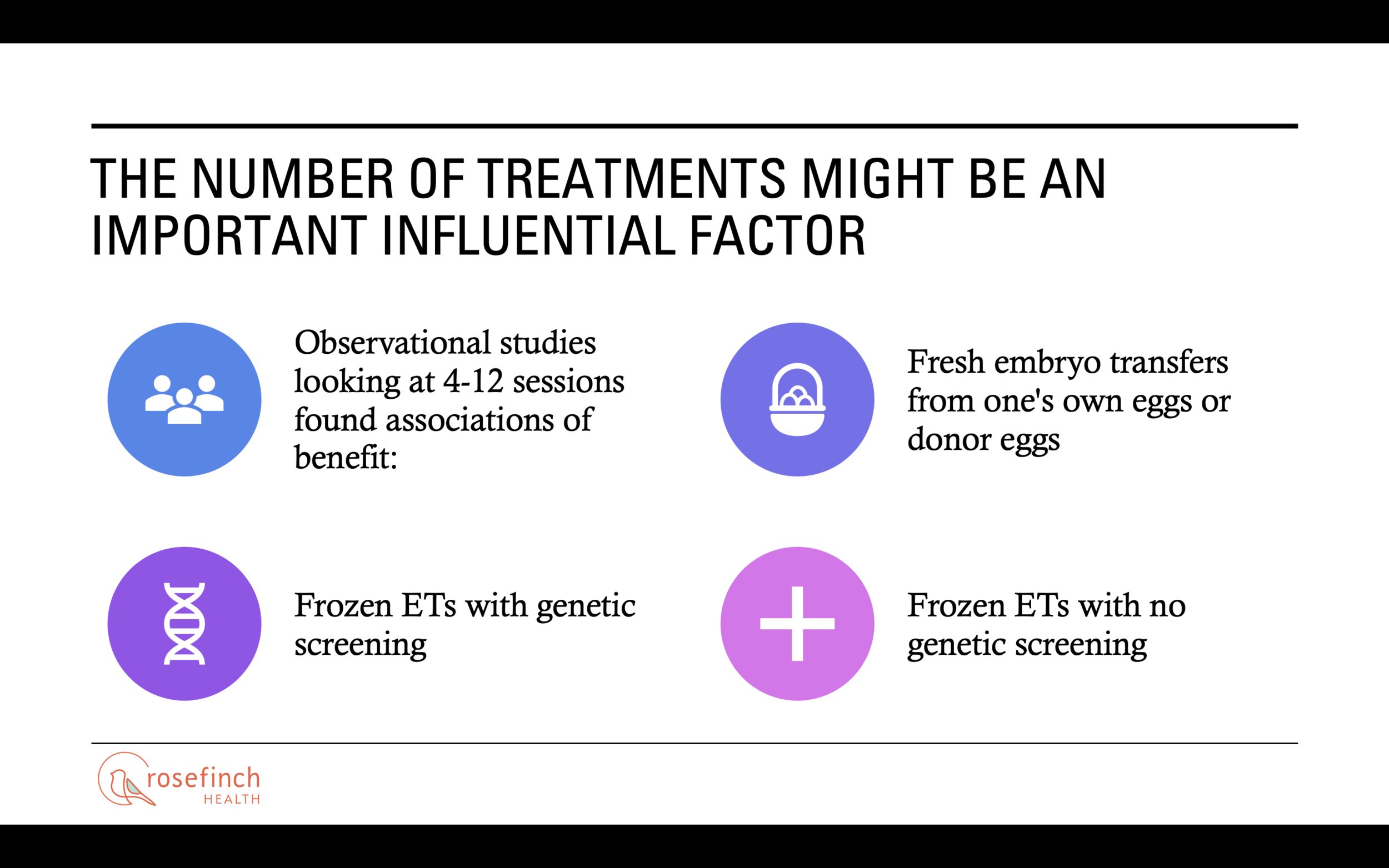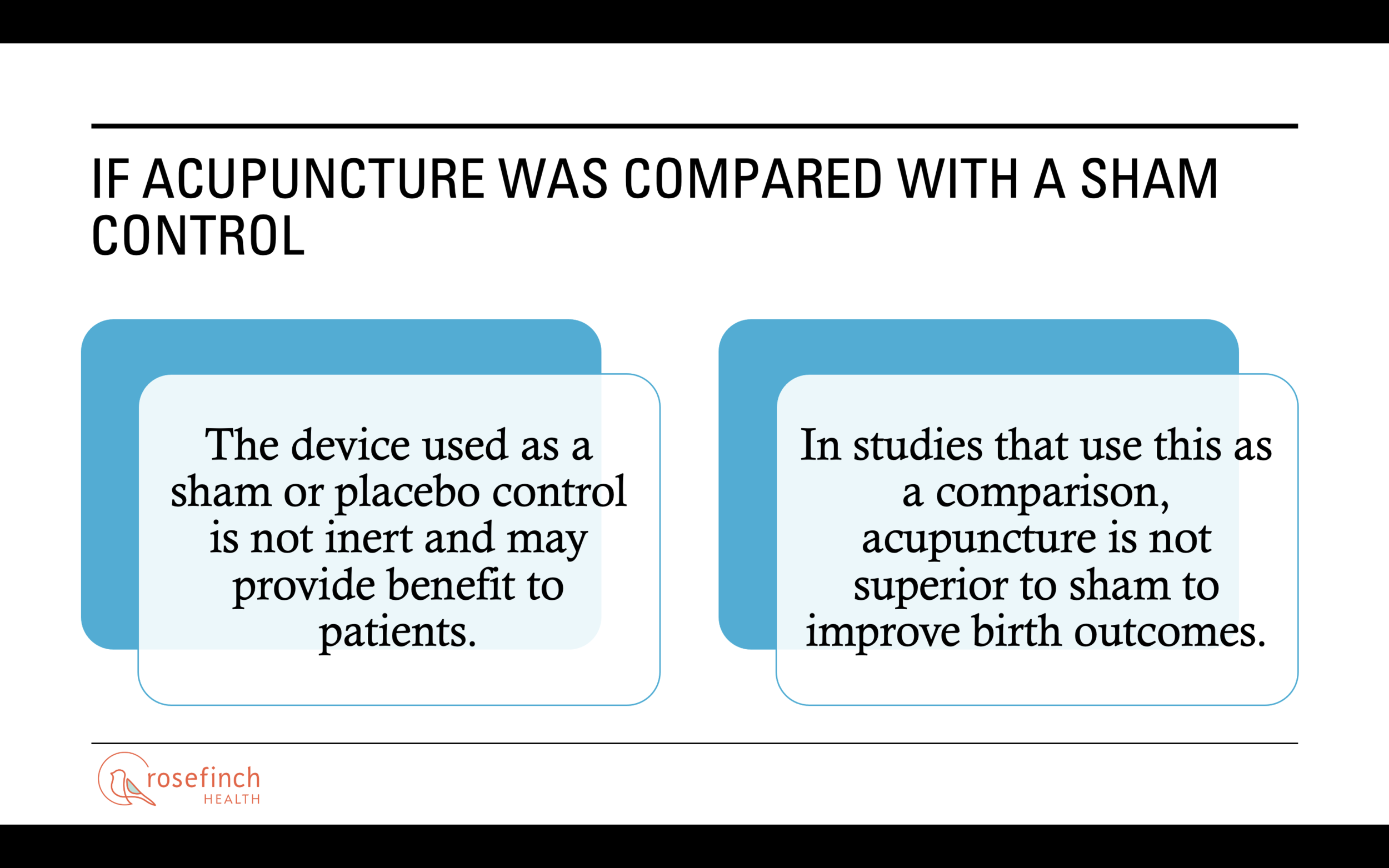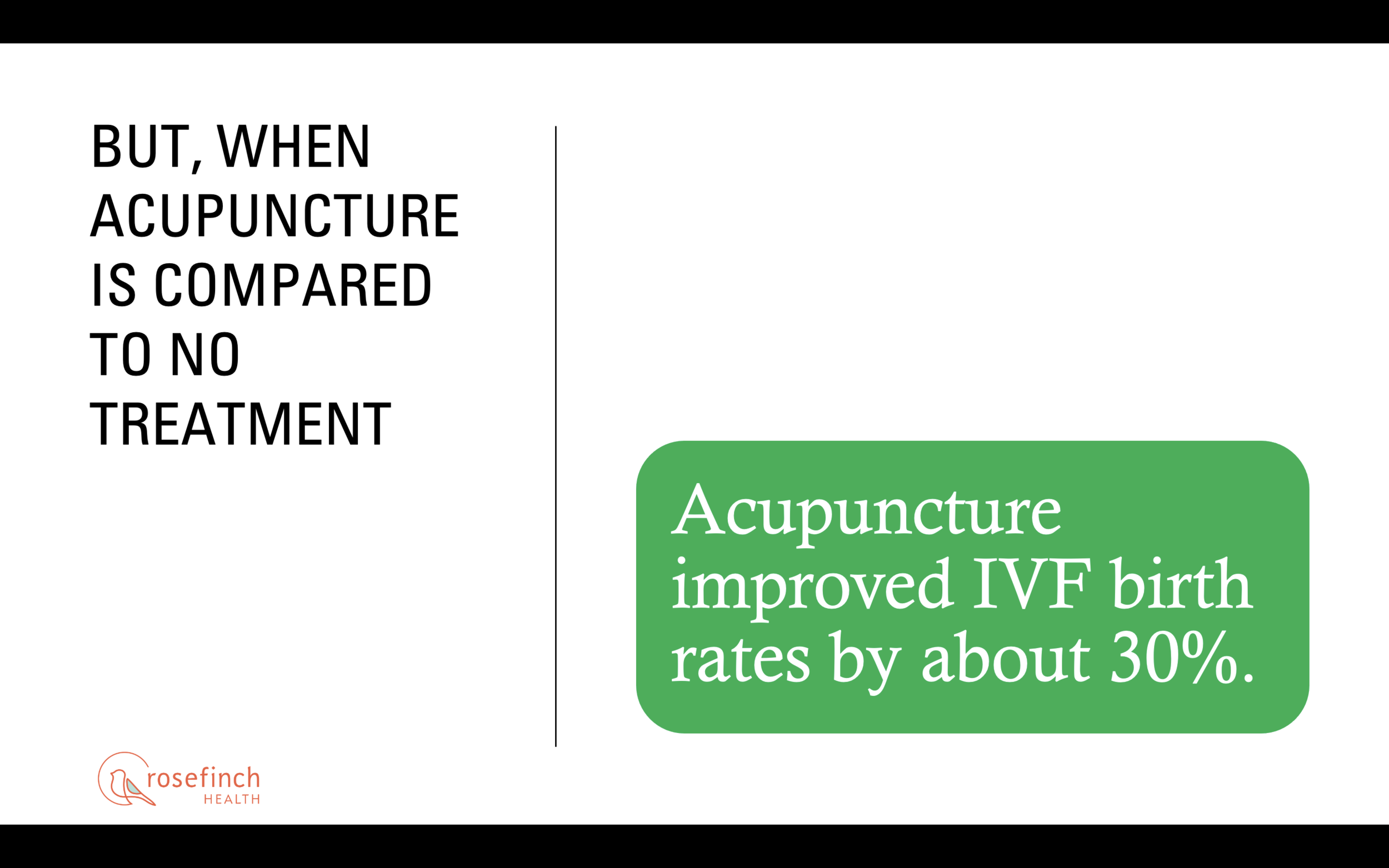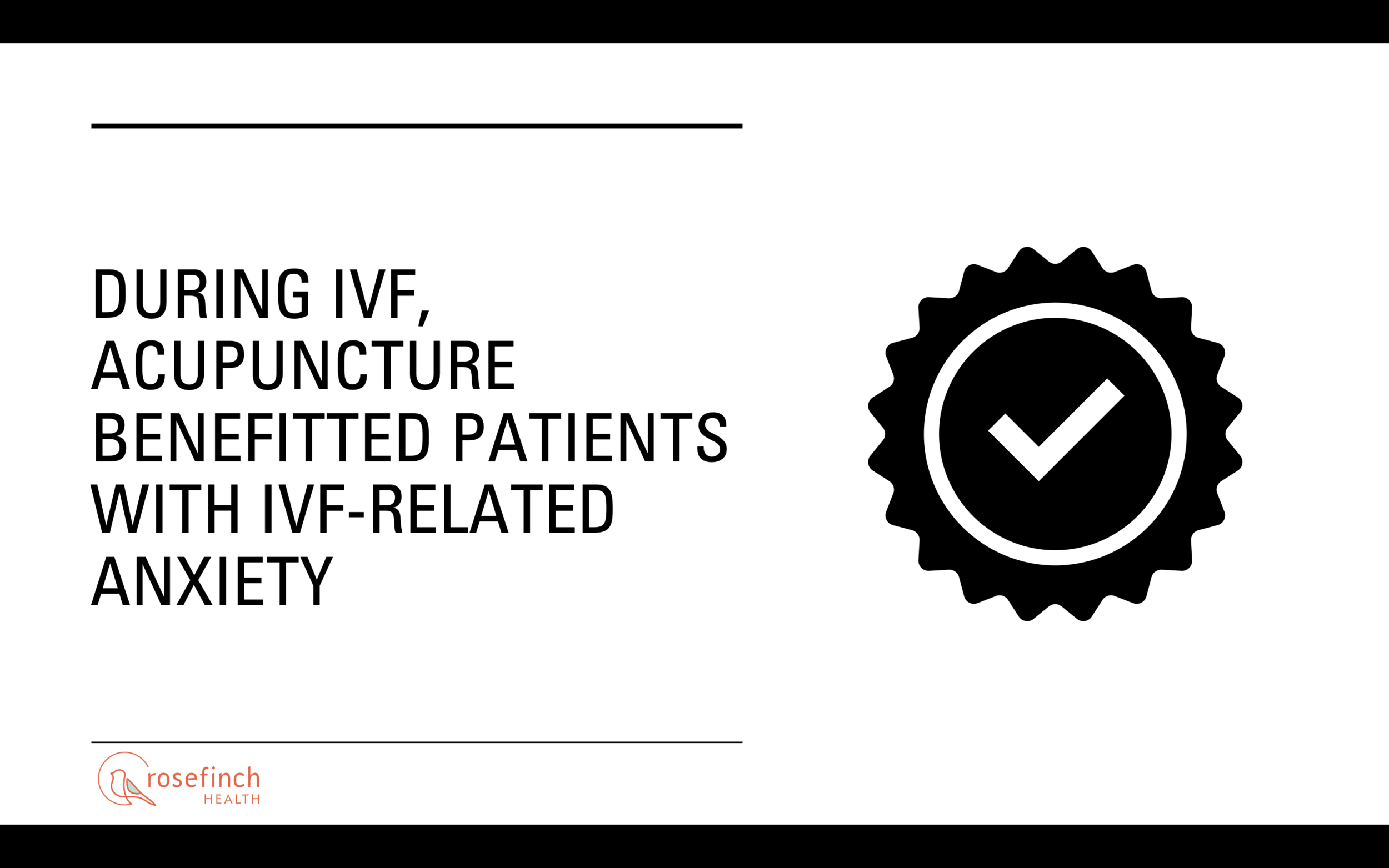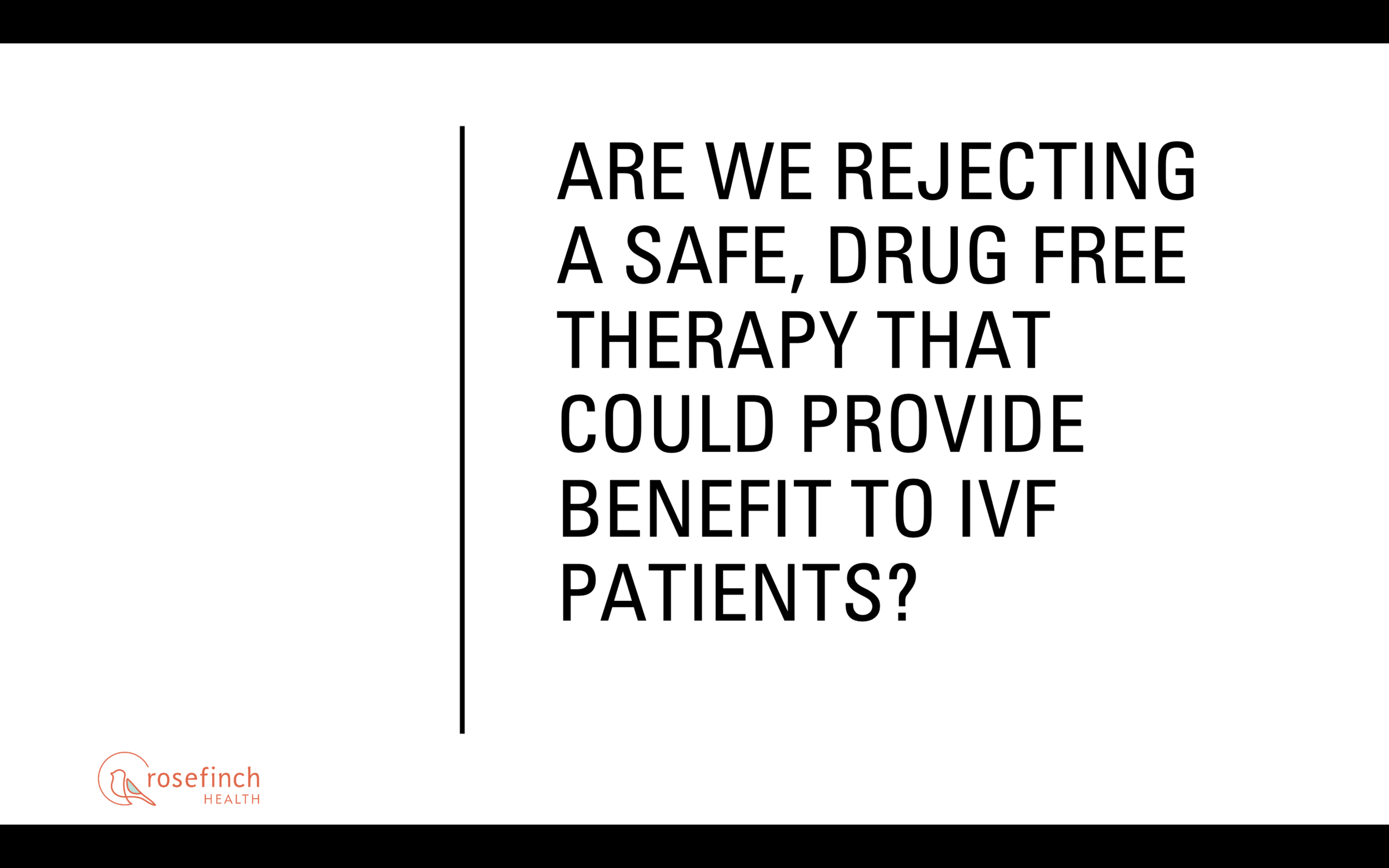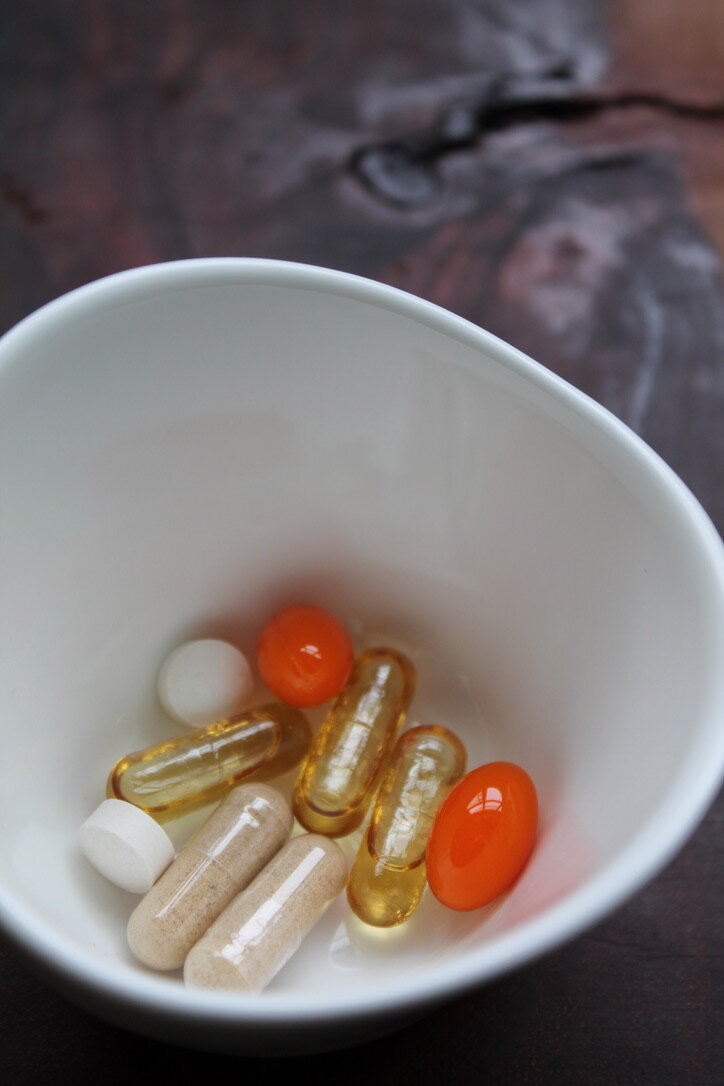Does acupuncture improve IVF success rates?
When trying to conceive, patients want to improve their chances of success. Many turn to acupuncture to support them during their IVF cycle. A reasonable question is: does acupuncture improve IVF success rates? Before I answer this full disclaimer, I am an acupuncturist and clinical researcher by training. I have published several studies on acupuncture as a treatment to support IVF patients. I've also written a couple of papers critiquing the research. It is my conclusion that the answer to whether acupuncture improves IVF outcomes boils down to two things:
1. the dose or number of acupuncture sessions attended during an IVF cycle, and
2. what acupuncture was compared with in a randomized, controlled trial (RCT).
When patients attend at least 6 acupuncture sessions (including two at embryo transfer), they may benefit from acupuncture to improve their chances of pregnancy and live births from:
• Fresh IVF with one’s own eggs[1]
• Fresh IVF with donor eggs [1]
• Frozen ETs with embryos that were not genetically tested [2]
• Frozen ETs with genetically screened normal embryos[3]
These were cycles where acupuncture was associated with better outcomes when compared with only two sessions on the day of embryo transfer [1-3] or no additional treatment at all. [1]. The limitations to this data are that these studies were not randomized, so the results observed are only associations of benefit. A follow up RCT is needed.
However, and here is where things get confusing, the data from RCTs usually looks at two sessions of acupuncture provided around the embryo transfer (immediately before and after). In that smaller “dose,” acupuncture added to IVF (fresh and frozen) improves the chances of live birth by about 30% when compared with no treatment. [4, 5] Still, there is no clinically meaningful improvement with acupuncture when compared with "sham" acupuncture. [4, 5] If taken on its face and applying the research method, one would naturally conclude acupuncture doesn't help because it is not superior to placebo. But, herein lies the paradox!
First, IVF success rates continue to improve year by year. The first studies of acupuncture added to IVF were when the baseline pregnancy rate was in the low 30% range. According to the latest CDC SART data, the national average is in the low 50% range, with some clinics' live birth rates in the mid-70% range. As an acupuncturist, I am not sure I would expect two stand-alone acupuncture sessions as a reasonable intervention to improve IVF success rates. One injection of gonadotropins is not enough to adequately stimulate one's ovaries; a series of injections over a short period is more effective. This is also true with acupuncture. It is not a one-and-done treatment. While one session was enough to improve markers of glucose metabolism in one study of women with PCOS,[6] a series of eight sessions over four weeks was needed to improve blood flow to the uterus.[7] Of note, acupuncture on the day of embryo transfer does appear to help reduce IVF-related anxiety.[8]
Second, sham acupuncture is intended to be a placebo – aka inert, nothing, nada, zilch, zip! Unfortunately, there is reasonable evidence demonstrating sham acupuncture is, in fact, not inert. One study found sham acupuncture's effectiveness was about 20% more than a typical placebo, aka sugar pill, used in research.[9]Another study found sham needling caused the body to release endorphins into the bloodstream to the same degree as real acupuncture. [10] These findings suggests that sham acupuncture is likely not inert and instead benefits study participants who receive it. In many of the trials using sham needles, study authors often refer to the possibility that the sham needles may not be inert.[11, 12]
If it is true that the sham provides benefit, and we don't see any difference between real and sham acupuncture. Still, we DO find a difference between real acupuncture and no treatment. Are we rejecting a potentially beneficial therapy in error? Why do we see robust differences in live birth rates between patients who attend more acupuncture compared with those who just do the day of embryo transfer acupuncture in observational research? It seems we are looking at the wrong dose of acupuncture and expecting two treatments to perform a miracle to improve birth outcomes.
We don't have a clear answer. We haven't yet figured out the best method to control for acupuncture in RCTs, but honestly, we aren't alone in this. Other areas of medicine face similar challenges. For example, what is a reasonable control method for a surgical procedure, a sham surgery? Can we ethically put a study participant under anesthesia, cut them open, perform a "sham" surgery, sew them back up, and look at who did better? And we aren't clear on the exact number of acupuncture sessions needed to improve IVF success rates. It seems like it is at least more than 3.[4] Finally, the evidence has not kept up with the current IVF practice. More and more cycles are FET cycles, not fresh IVF embryo transfers. Nearly all of the published acupuncture IVF trials were, save for one, done with fresh transfers.
While there are more questions than answers, here is what we know:
1. If we take the evidence on its face, two acupuncture sessions are not superior to a sham control to improve birth outcomes when provided on the day of embryo transfer. However, the sham control is likely not inert, so we may be inadvertently rejecting a treatment that could provide benefit.
2. When two acupuncture sessions are compared to no treatment, success rates (live birth) improve by 30%, and likely benefits patients with IVF-related anxiety.
3. More sessions of acupuncture may provide more benefits. When 9-12 sessions are added to an IVF cycle, acupuncture was associated with robust improvements in pregnancy and birth rates.
4. We don't have a lot of evidence on FETs yet. There is only one trial where acupuncture was compared with sham control. In that study, the sham control group performed better than the real acupuncture group. Again, sham needling is likely not inert.
5. The observational research suggests 6 sessions of acupuncture (including the day of embryo transfer acupuncture) are associated with more live births than just two acupuncture sessions at embryo transfer.
Reach out via the contact us page with any questions or comments about this post. We clearly need more well-designed research. Thanks for reading to the end!
References
1. Hullender Rubin, L.E., et al., Impact of whole systems traditional Chinese medicine on in vitro fertilization outcomes. Reproductive Biomedicine Online, 2015. 30(6): p. 602-612.
2. Rubin, L.H., et al., Birth outcomes from acupuncture added to frozen embryo transfer (fet) of autologous embryos without genetic screening: a retrospective cohort study. Fertility and Sterility, 2020. 114(3): p. e330.
3. Rubin, L.H., et al., Impact of acupuncture and traditional chinese medicine (TCM) on frozen embryo transfers (FET) of autologous embryos with comprehensive chromosomal screening (CCS): a retrospective cohort STUDY. Fertility and Sterility, 2020. 114(3): p. e450-e451.
4. Smith, C.A., et al., Acupuncture performed around the time of embryo transfer: a systematic review and meta-analysis. Reprod Biomed Online, 2019. 38(3): p. 364-379.
5. Xie, Z.Y., et al., The effects of acupuncture on pregnancy outcomes of in vitro fertilization: a systematic review and meta-analysis. BMC Complement Altern Med, 2019. 19(1): p. 131.
6. Benrick, A., et al., Autonomic nervous system activation mediates the increase in whole-body glucose uptake in response to electroacupuncture. FASEB, 2017. 31(8): p. 3288-3297.
7. Stener-Victorin, E., et al., Reduction of blood flow impedance in the uterine arteries of infertile women with electro-acupuncture. Human Reproduction, 1996. 11(6): p. 1314-7.
8. Chu, K., et al., A systematic review and meta-analysis of nonpharmacological adjuvant interventions for patients undergoing assisted reproductive technology treatment. International Journal of Gynecology & Obstetrics, 2017. 139(3): p. 268-277.
9. MacPherson, H., et al., Influence of control group on effect size in trials of acupuncture for chronic pain: a secondary analysis of an individual patient data meta-analysis. PLoS One, 2014. 9(4): p. e93739.
10. Harris, R.E., et al., Traditional Chinese acupuncture and placebo (sham) acupuncture are differentiated by their effects on mu-opiod receptors (MORs). Neuroimage, 2009. 47(3): p. 1077-1085.
11. So, E.W., et al., Acupuncture for frozen-thawed embryo transfer cycles: a double-blind randomized controlled trial. Reprod Biomed Online, 2010. 20(6): p. 814-21.
12. Smith, C., M. Coyle, and R.J. Norman, Influence of acupuncture stimulation on pregnancy rates for women undergoing embryo transfer. Fertil Steril, 2006. 85(5): p. 1352-8.
Tonight is the winter solstice, the longest night of the year and when Jupiter will cuddle up with Saturn.
The great conjunction of Jupiter and Saturn is a once in 800-year event. It is unique because this is the first Jupiter-Saturn conjunction to occur at night in the northern hemisphere and on the winter solstice — the longest night of the year. It is the official start of Winter!
Beauty in the sky.
Jupiter and Saturn are the largest planets in the sky. Tonight, Saturn will align so close to Jupiter that NASA says that when looking with the naked eye, the space between them will only be the thickness of a dime! It is called the "great conjunction" of Jupiter and Saturn and will appear very bright on the night sky's southwest horizon. It will be beautiful, so take a moment to look up at the sky if it is clear to catch a glimpse of this celestial event.
Wow, this is really cool!
The great conjunction of Jupiter and Saturn is a once in 800-year event. It is unique because this is the first Jupiter-Saturn conjunction to occur at night in the northern hemisphere and on the winter solstice — the longest night of the year. It is the official start of Winter!
2020 has been a terrible, horrible, no good, very bad year.
This year has been really hard. I'm pretty sure you already knew that. We are all exhausted from an emotionally, physically, and spiritually taxing year. We cannot see our friends or loved ones for fear of making them sick. We have integrated face masks into our wardrobes. Many are out of work or are fighting to keep their hard-won small businesses from collapsing. Others have lost dear ones to COVID-19. Some have to delay fertility treatments because they lost their health insurance and can no longer afford them. Others are unsure they want to continue with so many unknown risks from COVID-19. All of this in the setting of a chaotic administration, political unrest, and a country finally awakened to widespread racial disparities in housing, policing, pay, and healthcare access. It can feel like we are residing in and barely making it through one of the darkest periods of our lifetimes. And yet, Jupiter cuddling up with Saturn shines a light in our collective darkest hour.
The light at the end of a dark tunnel?
Could the great conjunction represent the light at the end of long darkness? I am choosing to see it in this way. With the advent of the vaccine, a new economic package that will provide some relief, the incoming administration will hopefully implement a substantial change in managing the COVID-19 response. I don't know what our new normal will look like, but I look forward to discovering it.
Take a break.
The start of Winter while Saturn cuddles up with Jupiter and appearing like the brightest "star" in the sky on the longest, darkest night of the year also reminds me of something within the theory of East Asian Medicine (EAM).* The theories underpinning EAM emerged and were refined from careful observation of the interplay between climate, nature, and humans. Think of those theories as one more way to understand how the body works when well or unwell. Early classical texts describe Winter as the time for rest. It is a time where we spend more time indoors, get more sleep, slow down, restore from the hard work of autumnal harvests, and prepare for spring activities. With the pandemic and stay at home orders, this may feel like the worst time in the world to rest. For many, 2020 has been a year of immeasurable stress that few were prepared for. Taking more time to relax may feel counterintuitive right now. But like the brightness of two planets mutually supporting each other, think of this rest as a way to revive you and prepare you for the days ahead.
Take a break, friend.
Three informative books that may help you have a baby
When searching for informative books to help you conceive, there can be too many from which to choose. Here are three informative books that may help you have a baby.
When searching for informative books to help you conceive, there can be so many books from which to choose. A sense of being overwhelmed quickly sets in. You don’t have to fall down an internet rabbit hole – I did a little research for you. I read a lot and have an extensive collection of informative texts on infertility. Consider these three texts as excellent resources for your library.
Planting the Seeds of Pregnancy: An Integrative Approach to Fertility Care
Integrative fertility care is central to Rosefinch Health, which is why I recommend this book. A collaboration by fertility acupuncturist Stephanie Gianarelli, LAc, FABORM, and fertility doctor, Lora Shahine MD, FACOG, Planting the Seeds of Pregnancy is like a collegial conversation between experts. They describe how they use their respective expertise to support patients. Full disclosure, I know these two authors in real life and am huge fans of their work, advocacy, and excellence. There are several books on infertility and East Asian medicine. The book is an excellent, accurate, and practical handbook that is also a quick read. It concisely outlines tangible steps patients can take to prepare for pregnancy when trying naturally or when going through conventional reproductive medical interventions like in vitro fertilization. They also describe how to successfully integrate acupuncture and East Asian Medicine into your fertility treatments with case examples from their practices. If you don’t have a lot of time and want some quality information and pragmatic advice on lifestyle, diet, toxin risk reduction, and potentially improving your chances of having a baby, Planting the Seeds of Pregnancy is an excellent text.
It Starts with the Egg
Egg quality is a vital factor to successful fertilization, implantation, and subsequent full-term pregnancy. Can you improve it? While you cannot increase the number of eggs, this popular book by Rebecca Fett, now in its second edition, It Starts with the Egg, empowers the reader with ways to reduce the impact of aging, poor diet, and a less than healthy lifestyle on egg quality. She takes a deep dive into reproductive physiology without alienating a reader with excessive jargon. This book covers a lot of ground on toxins that harm fertility, supplements to support egg health, fertility-friendly dietary suggestions, and even ways to address sperm quality. Fett made wading into the research science approachable, and even enjoyable, reading.
Not Broken: An Approachable Guide to Miscarriage and Recurrent Pregnancy Loss
I highly recommend this third book if you are one of every four who have had a miscarriage at some point in your attempts to build your family. Because miscarriage is sadly a prevalent occurrence, I wanted to include this book, Not Broken, by Lora Shahine MD. Yes, this is the second recommendation to include this author. In addition to her collaborations with integrative medicine, Dr. Shahine is a fertility doctor who is also a nationally recognized expert on miscarriage and recurrent pregnancy loss. I am recommending this book for two reasons. First, Dr. Shahine is a compassionate writer who explains what we know about miscarriage and what can you can do to reduce your risk. Second, the book is another quick read but chock full of expert advice aimed at supporting eggs, womb, or sperm through modifications to diet and lifestyle. She also spends some time discussing common reproductive toxins encountered in our daily lives and how to reduce your exposures.
Common questions: do you have experience with my diagnosis?
In this blog, we answer questions about who benefits from integrative fertility support. We also describe our experience with IVF, IUI, and a broad list of infertility causes.
Do you have experience with my diagnosis?
If you are reading this, then you are looking for ways to help yourself as you are trying to conceive and build your family. We are so happy you are here. In this virtual practice, you will have access to an experienced provider of fertility and IVF support with integrative and East Asian Medicine. One of your first questions may be, “are you experienced, aka, have you worked with someone like me before?” This is a fair and critical question to your success. In the last two decades, we have supported thousands in the journey to parenthood. If you are:
taking Clomid as part of an artificial insemination cycle with or without donor sperm
planning your next egg retrieval so you can freeze your eggs for when you are ready
gearing up for your next embryo transfer
planning with your partner to work with an egg donor and gestational carrier
timing intercourse with your basal body temperature and ovulation predictor kit
sharing maternity with your partner and planning a reciprocal IVF cycle
stressed out and need someone to help you cope
We have the experience, compassion, and knowledge to assist you. It doesn’t matter who you are, what you are doing, or where you are in the process; we are here to help. We support:
Black, Latinx, Indigenous, Asian, Pacific Islander, Person of Color, or White;
Single, Partnered, or Married;
Lesbian, Gay, Bisexual, Transgender, Non-binary, Queer, Two-Spirit, Intersex, Asexual, Heterosexual, Cisgendered, or other gender identities or sexual orientations;
HIV+ or status discordant couple;
Preserving fertility before cancer treatment or in survivorship
We use integrative health approaches to provide fertility and IVF support. Our founder is an award-winning clinician and researcher. She has developed a program to support you through your journey to parenthood with as few or as many visits as you need, no additional needle pokes, and safe, evidence-based therapies. With her program, we can focus on eggs, the womb, sperm, or assisted reproductive treatment. Our primary objective is to empower you with science-based strategies targeted to your optimize your reproductive needs and goals.
Does NMN improve egg quality?
Does NMN improve egg quality? In this post, we dive into the latest study from Australia on NMN and its effects on your eggs.
To have a healthy pregnancy, we need healthy eggs. Egg quality is an essential contributor to fertility and fecundity. We know we can't increase the number of eggs we have but are there ways to improve egg quality? One strategy to boost egg quality has been to look at different nutrients as potential therapy. NMN (nicotinamide mononucleotide) is a nutritional supplement and precursor of NAD+ (nicotinamide adenine dinucleotide). Egg quality declines with age. We also know that NAD+ stores decline and induce a cascade of effects from mitochondrial dysfunction affecting multiple organs, including ovaries, in humans and mice. In studies, NMN effectively reduced the severity of many age-related diseases in rodents fed the supplement. Based on these findings, daily NMN supplementation is hypothesized to enhance NAD+ availability and could be an efficient, cheap therapy for age-related diseases like infertility.
To find out, researchers from the University of Queensland, Australia, investigated this question by providing a small, daily dose of NMN to older mice over four weeks to determine if the supplement improved egg quality. In their study, the authors found that NMN reversed the impact of aging on egg quality and increased fertility in mice and did not harm offspring. These results are exciting as there are currently no other therapies known to reverse the aging of eggs in humans. It is especially relevant as more people delay conception to an age when egg quality markedly declines. Our risk for aneuploidy—genetically abnormal embryos—increases while simultaneously the likelihood of carrying a pregnancy to term or delivering a child decreases.
These research findings are exciting and hopeful toward a simple supplement that could reverse aging effects on egg quality. Unfortunately, the study did not establish efficacy in humans to improve egg quality – only mice. While indeed promising, this study provides preclinical evidence strongly suggesting further research is needed to learn if the mice's findings also translate to humans. At this time, we do not know if any NAD+ precursors like NMN would be equally successful in humans, nor do we know the appropriate dose or duration of treatment to improve outcomes. The authors also pointed out notable limitations to their study: they did not look at the influence of Reactive Oxygen Species (oxidative stress) or the G6PD activity (a marker of glucose metabolism), which can significantly impact egg quality.
Studies of NMN's impact on aging suggest it is a safe nutrient when taken for short periods. But to be clear, the research is predominately underwritten by the same companies that manufacture the supplement. And, the studies have fewer participants of healthy adults over 50 years old. NMN showed benefit in mice in this preclinical study, which is an important finding and the first step in this nutrient's scientific inquiry. But we do not know if these results will translate to humans, nor do we know the human NMN dose needed to reproduce the effects found in mice. We are also unclear about how long one should take the supplement. While we always see the statement, "more research is needed," it is especially true whenever astounding results in an animal study and no human studies yet exist. We expect this strong signal of NMN benefit to egg quality will likely trigger more studies in humans.
What can you do now to help improve your egg quality? We have other ways to support you in your journey to parenthood. Contact me to learn ways to optimize your egg quality and fertility.
Common questions: Cracking the fertility acronym code
What’s with all the fertility-related acronyms used online? We break the code and provide the key to the most commonly used fertility-related acronyms.
What is it with all of these acronyms?
If you have spent any time on the internet searching for information about your fertility, you have no doubt encountered a coded alphabet soup of acronyms. What do they mean? Here’s a quick and handy key of the most commonly used fertility-related acronyms related to fertility and reproductive medicine.
2WW = two week wait
ACU = acupuncture
AMA = advanced maternal age
AMH = anti-müllerian hormone
ARA = advanced reproductive age
ART = assisted reproductive technology or IVF
BBT = basal body temperature
BCP = birth control pill aka OCP
BD = baby dancing aka intercourse
Beta = HcG pregnancy test
BFN = big fat negative
BFP = big fat positive
CB = cycle buddy
CD = cycle day
CF = cervical fluid
CHM = Chinese herbal medicine
CM = cervical mucus
DH = dear husband
DE = donor egg
DOR - diminished ovarian reserve
DPI = days post insemination
DPO = days post ovulation
DPR = days post retrieval
DPT = days post transfer
DW = dear wife
DX = diagnosis
ENDO = endometriosis
EPT = early pregnancy test
ER = egg retrieval
ET = embryo transfer
FET = frozen embryo transfer
FF = fertility friend
FHR = fetal heart rate
FSH = follicle stimulating hormone
FTTA = fertile thoughts to all
GC = gestational carrier or surrogate
HCG = human chorionic hormone aka pregnancy hormone
HGH = human growth hormone
HPT = home pregnancy test
HSG = hysterosalpinogram
HX = history
ICSI = intracytoplasmic sperm injection
IF = Infertility
INF = infertility
IVF = in vitro fertilization
IUD = intrauterine device like mirena or paragaurd
IUI = intrauterine insemination
LAP = laparoscopy
LH = luteinizing hormone
LMP = date of the first day of the last menstrual period
LSP = low sperm count
MC = miscarriage, aka m/c or misc. or SAb
MF = male factor
OCP = oral contraceptive pill aka BCP
OPK = ovulation predictor kit
OTC = over the counter
OV = ovulation
PIO = progesterone in oil injection
PCOS = polycystic ovary syndrome
PG = pregnant
PGT-A = pre-implantation genetic testing for aneuploidy (extra or missing chromosomes like Down syndrome)
PGT-M = pre-implantation genetic testing for monogenic or single gene disorders like cystic fibrosis or Huntington Disease
PGT-SR = pre-implantation genetic testing for structural rearrangements like translocations
PI = primary infertility
PMS = premenstrual syndrome
POAS = pee on a stick
POF = premature ovarian failure
RE = reproductive endocrinologist aka fertility doctor
RPL = recurrent pregnancy loss
SA = sperm analysis
SHG = sonohystogram
SI = secondary infertility
SIS = saline infused sonohystogram
TL/TR = tubal ligation, tubal reversal
TSH = thyroid stimulating hormone
TTC = trying to conceive
TTCAR = trying to conceive after reversal
TVUS = transvaginal ultrasound
TWW = two week wait aka 2WW
TX = treatment
US = ultrasound
V/VR = vasectomy, vasectomy reversal
Let us know if we are missing anything! Email us at hello@rosefinchhealth.com
Common questions: what is integrative fertility support?
Integrative fertility support encapsulates many strategies. In this post, learn the ways we can optimize eggs, the womb, and sperm to help you conceive and have a healthy baby.
We use integrative and East Asian medicine fertility telehealth support as our approach to helping you reach your family building goals. Our initial visit is comprehensive and broken up into two 50-min sessions. In the first session, we will gather all of your health information, request your medical records, and obtain a thorough health history. We will identify your goals and strategies to achieve them, order any necessary lab tests, and place any appropriate referrals. Collaboratively, we can decide how we want to work together. At the second visit, we will outline the integrative health approaches recommended to support your goals and desired outcomes. These approaches can include:
Dietary modifications
Lifestyle modifications
Environmental modifications
Reproductive education
Acupressure or self-massage
Appropriate referrals
TEAS
Sleep support strategies
Stress reduction strategies
Nutritional supplementation
Herbal therapy
At Rosefinch Health, we deliver all of our sessions virtually. You will have to make fewer visits to an office, less hassle finding parking, and more freedom to do the things you want to do. You may only want the initial recommendations, or you may prefer ongoing support. Both are possible – we strongly feel being responsive to your needs is vital to our mission. Still have questions? Contact us below.



